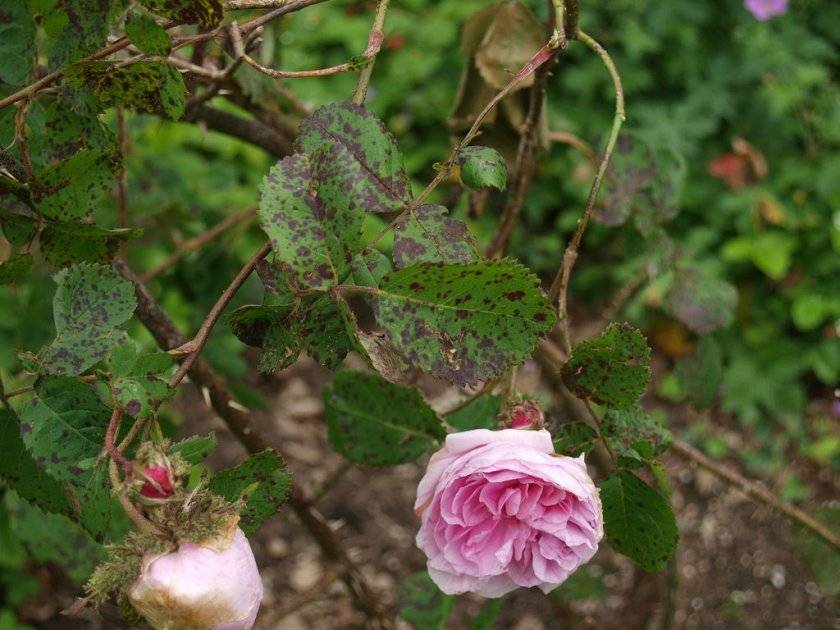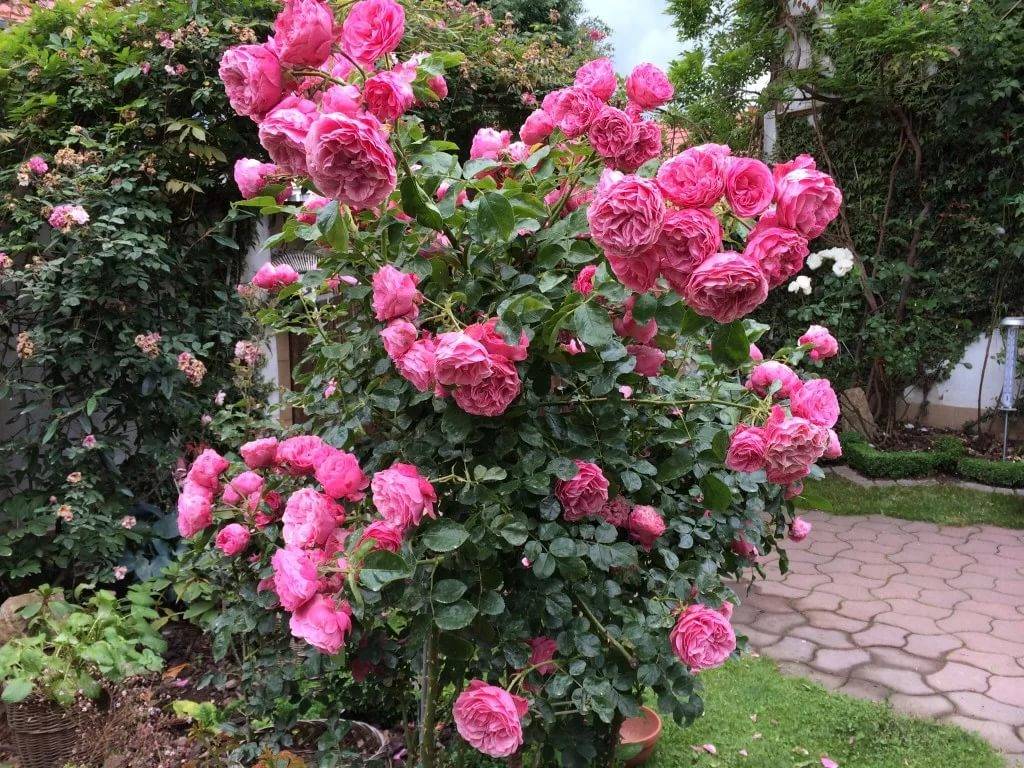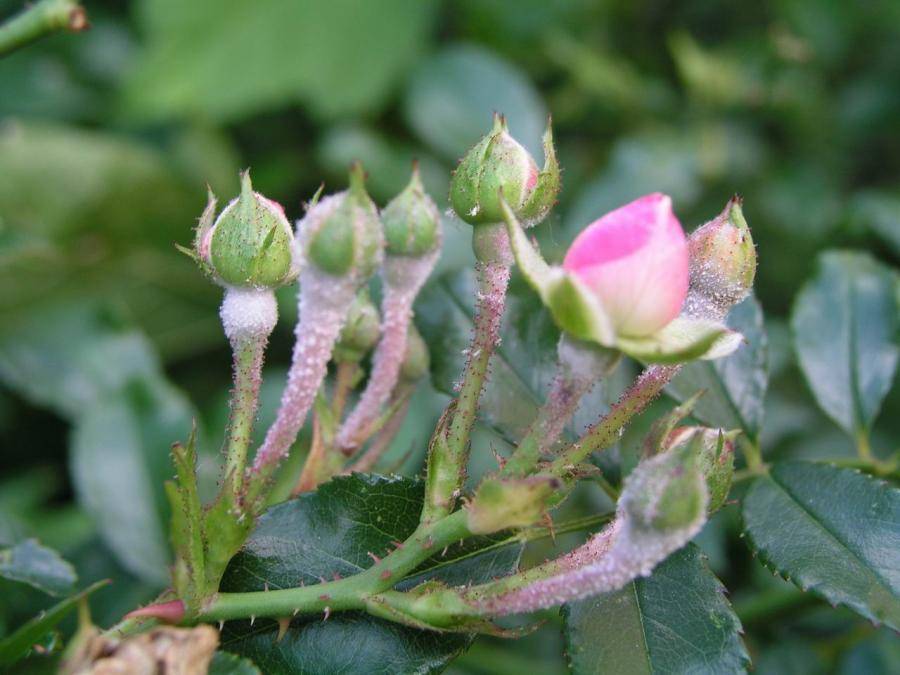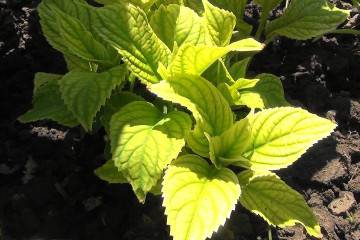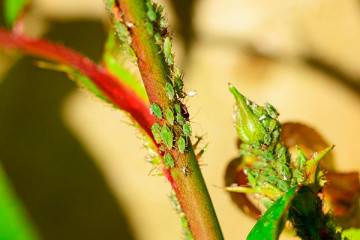White bloom on roses - what is it and how to treat
Content:
The white bloom that appears on the leaves of a rose in summer cannot be ignored. In most cases, this is a symptom of a fungal disease, powdery mildew, manifested by the spread of the mycelium of the pathogen. Plants can be saved by vigorous measures to combat a dangerous disease. Letting the process take its course, you can lose valuable specimens of culture.
White bloom on roses - what is it
During the growing season, a whitish bloom resembling flour or powder can often be seen on the leaves of home and garden roses. The white powder can be easily wiped off the plant, but this should not soothe the grower. Fungal disease requires urgent action.
Why do the leaves and buds of a rose turn white
Whitish bloom can appear on all aerial parts of the plant: leaves, shoots, buds. Young foliage is most affected. The presence of plaque indicates the development of fungal diseases - powdery mildew and downy mildew. If untreated, the pathology can lead to the death of the plant and infect the crops growing nearby.
The main reasons for the appearance of white bloom on roses
An epidemic of fungal diseases occurs in warm weather and high humidity. The optimum temperature for the development of the pathogen is + 20-25˚С, the air humidity is more than 80%.
Causes contributing to the onset of the disease:
- thickening of landings;
- excessive shading;
- growing on heavy soils with poor aeration;
- calcium deficiency;
- strong drops in day and night temperatures;
- transmission of spores by parasitic insects;
- excess nitrogen in the soil.
Powdery mildew
A fungal disease accompanied by the appearance of a white coating on plants is called powdery mildew. Why does the disease appear? The main reasons for the spread of the pathogen are unfavorable weather conditions and violations of the rules of agricultural technology of flower culture. The disease has the ability to progress rapidly, often covering large areas.
The causative agent of powdery mildew, its pathogenicity
The cause of the disease is the exoparasitic fungi Sphaerotheka pannosa. Mature spores of the fungus can be transported over long distances: fly through the air, spread through harmful insects, and be transmitted through clothing and agricultural implements. The causative agent hibernates in leaf litter, bark cracks.
Why is powdery mildew dangerous?
Fungi feed on the sap of the host plant. The removal of nutrients leads to disruption of photosynthesis. If the plant is not treated, the flower sheds its leaves and dies. A disease that began in the fall poses a threat that the rose will not survive the winter cold.
Powdery mildew is dangerous by its spreading speed. The mycelium of the fungus grows rapidly and passes to neighboring cultures. Under unfavorable circumstances, without taking measures to combat the disease, a fungus that affects one rose bush can destroy the entire collection in a week.
Signs of defeat
Whitish spots on leaves and young shoots are the initial sign of infection. As the spores mature, sticky drops of moisture appear at the site of the plaque. The ground parts of the affected plant become shiny. Mycelium spots are most common on parts of the plant close to the ground. Gradually, the spots grow, merge with each other, and become denser.
Affected leaves and new leaves that appear roll up into a tube, dry up, fall off. The plant stops growing. On home roses, bud formation is suspended. The disease greatly weakens the plant. In autumn, dark dots appear on the leaves - clestothecia. In them, spores are formed, intended for wintering. Spores are highly viable: under favorable conditions they can persist for several years.
How to deal with white bloom with powdery mildew
What to do if the leaves of a rose turn white? The first step is to remove all affected parts of the plant and the top layer of soil near the flower. In indoor roses, up to a third of the upper layer of the substrate is removed, which may contain spores of the fungus. Treat small areas with home remedies. In advanced cases, it is necessary to use fungicides.
Folk remedies
Recipes for remedies against powdery mildew on roses, which you can make yourself:
- 1 kg of ash is stirred in a bucket of warm water and infused for 3-4 days. The resulting solution is filtered through cheesecloth, a teaspoon of liquid soap is added. The resulting infusion is sprayed on the plant. The remaining mixture is diluted with water in a ratio of 1: 1 and the plant is watered at the root.
- 1 tbsp. l. baking soda, 1 tsp. liquid soap is stirred in 5 liters of water heated to 50˚C. The resulting solution is sprayed with indoor and outdoor roses. Processing is carried out 2-3 times at weekly intervals.
- 1 liter of whey in 1 bucket of water. Plants are sprayed with the solution.
- 3 cloves of chopped garlic insist in 1 liter of water for 24 hours. The solution is filtered, the diseased bushes are sprayed.
Chemicals
Spraying roses with fungicides is carried out with a strong spread of the disease. The bushes should be processed in cloudy weather in the early morning or evening, observing safety precautions.
Effective preparations against powdery mildew:
- 1% Bordeaux liquid - 100 g of copper sulfate, 100 g of slaked lime are taken for 10 liters of water. Filter the prepared solution before spraying.
- "Topaz" - used in the fight against powdery mildew and rust. Available in 2 ml ampoules. For the treatment of bushes, take 1 ampoule per 10 liters of water.
- "Forecast" (analogues "Profi Plus", "Agrolekar", "Chistoflor"). A new generation product that actively fights against fungal diseases of flower crops. 10 ml of the drug is diluted in a bucket of water.
- "Strobi" - the active ingredient is kresoxim-methyl, sold in packs of 2 g. 5 g of the drug is diluted in 10 liters of water for spraying rose bushes.
Chemical fungicides provide protection for 2-3 weeks. Periodically, it is necessary to change the drugs so that the pathogen does not develop resistance, which makes the treatments useless.
Biological agents against diseases are becoming more widespread. They are safe and can be used throughout the growing season. The preparations improve the soil structure and strengthen the immunity of perennials.
"Fitosporin", "Alirin B" - means based on the hay stick, which, when it gets into the ground, fights against pathogenic pathogens of fungal diseases. The funds are available in the form of liquid, paste, tablets.
Downy mildew
The causative agent of the disease is a pseudo-fungus of this. Peronosporous (Psudoperonospora cparsa). Fungal disease appears on roses in damp cool weather in spring and late summer, when there is a large difference between day and night temperatures and morning dew falls on the leaves.
Young leaves and small buds are more often affected. Brown spots appear on the leaf plates, the inner part of the leaf begins to whiten, becomes covered with a bluish bloom. The trunk and shoots are covered with reddish spots. The disease is localized on a young growth in the upper part of the bush.
Under unfavorable conditions, the disease spreads rapidly. The rose bush is greatly weakened, flowering stops. The pathogen overwinters in plant debris on the ground and in damaged areas of shoots.
Downy mildew control measures
Parts of plants affected by the fungus are cut off and burned. Rose bushes are sprayed with copper-containing fungicides.
How can you treat mold on roses:
- "Profit-Gold" is a two-component preparation that helps to fight rose diseases in cold, rainy years. 12 g of the product is diluted in 10 liters of water, sprayed with rose bushes with an interval of 8-15 days.
- "Acrobat" is a contact fungicide that actively acts against peronoporosis and other fungal diseases of roses. 20 g of the drug is diluted in 5 liters of water, the plants are sprayed. Re-processing is carried out after 14 days.
- "Ordan" - contains copper oxychloride and cymoxonil. Destroys mycelium and fungal spores. It is produced in powder form in bags of 12 and 25 g. To cure a bush, 25 g of the drug are diluted in 10 liters of water.
Disease Resistant Varieties
To reduce the likelihood of a culture dying from fungal pathologies, varieties with high immunity to diseases are grown.
Leonardo da Vinci
An ornamental shrub belongs to the floribunda category. Bred by an English breeder in 1994. The bush is dense, well leafy, 0.7-1.2 m high, with erect shoots. Flowers are densely double, pink-crimson with a fruity aroma. The flowering is undulating from late June to autumn. The variety is resistant to powdery mildew and spotting, average winter hardiness.
Wedding Belz
A variety of hybrid tea roses of German selection, bred in 2001. The bush is compact, 70-90 cm high. It blooms profusely, with long-lasting large pink flowers with a diameter of 10-15 cm. The rose is distinguished by high frost resistance and resistance to diseases.
New Down
An ancient variety of a large-flowered climbing rose with repeated flowering. The flowers are pale pink with a fragrant spicy scent. Shoots up to 5 m long twine along the supports. The variety is hardy, tolerates frost well, rarely gets sick.
William Shakespeare 2000
The hybrid belongs to the group of scrubs. The rose bush is erect, tall. It blooms profusely with large, double, fragrant flowers 10 cm in size with a red-purple hue. The variety is resistant to the main diseases of roses.
Rosarium Uterson
Rose from the Cordes group, bred in Germany in 1977. A climbing, highly developed bush with shoots up to 3.5 m long, blooms with densely doubled dark pink flowers. The variety is distinguished by its high disease resistance and winter hardiness.
Prevention of white bloom on rose bushes
The main condition for the successful cultivation of roses is the elimination of the main causes leading to fungal diseases of plants.
The main preventive measures:
- Plant varieties of roses that are resistant to powdery mildew and other diseases.
- Maintain the required distance between seedlings, taking into account the growth of the bushes.
- When planting on heavy soils, drainage 10-15 cm thick from crushed stone or expanded clay.
- Plant roses in areas with sufficient light.
- Thoroughly destroy or remove plant debris and leaf litter from the garden in autumn.
- Observe the schedule and rationing of fertilizing with mineral fertilizers.
- Good results are obtained by dusting rose bushes with wood ash several times during the growing season.
Preventive treatments with Fitosporin solution begin in May, every 10-14 days. The biologically active agent has proven its effectiveness in the fight against fungal diseases of roses.
Each grower should know how to process roses that are covered with a white bloom. Delay is fraught with serious consequences. The powdery mildew fungus strongly weakens the rose bushes, the disease quickly spreads throughout the site.



